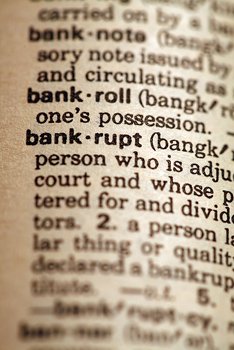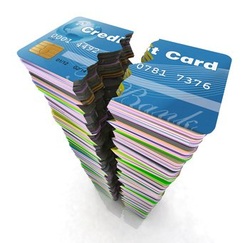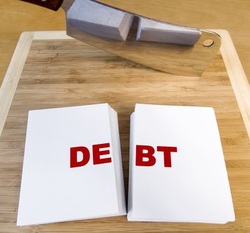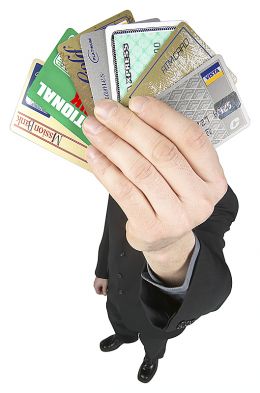 If you own a small business, you can expect a couple of debts to haunt you. This is a normal occurrence. From the moment you get a start up loan for the business, you are already in debt. The only difference with consumer debt is that any loan that you take for you business should help pay for itself. Your business generates revenues and any loan you take should be to improve that money making quality. However, there are instances wherein the debt payments can no longer be supported by the revenues. That means you have to start considering debt relief options. There are government programs that you can look into. The great thing about these programs is the fact that you can get lower than the usual interest rates. You can search through Grants.gov to provide you with options on what grants you can avail from the Federal government. These include mostly small business startup loans but they can also provide guarantees for debt assistance loans. Part of the ARRA or American Recovery and Reinvestment Act of 2009 states that tax relief are available for companies who are trying to cut back losses in order to cope with mounting debt. This is something that small business owners may want to look into. Apart from that, it provided over $700 million in funds for SBA loans. You should also know that whatever you can use in consumer debt can be applied in small business too. You can opt for debt consolidation loans or debt settlement. Of course, bankruptcy is also an option but this should be your last resort. All of these small business debt relief options can be effective for certain financial situations. In debt consolidation loans, the idea remains the same - you take out a big loan to cover for your other credit obligations. The idea is to stretch your loan longer so you get to pay smaller monthly payments. As your debt payment becomes smaller, you free up more funds to invest them in campaigns and strategies that will help increase the revenues of your business. Debt settlement is also an option that you can look into. Since a lot of small business entrepreneurs function as sole proprietors, they can qualify either as individual consumers or as a business owner. They get to enroll in a program wherein the debt settlement expert will review the financial capabilities of the business to consider how much it can pay their debts while having enough to cover for the overhead expenses. They will negotiate with the creditors on their behalf so the debt is reduced and the penalty charges are waived off. The last option that small business owners face is bankruptcy. There is a specific chapter known as the Chapter 11 bankruptcy that entrepreneurs can file. It is also known as the Reorganization bankruptcy and it will allow small businesses in debt to get loans with favorable interest rates. These loans will help them stay afloat. It is no longer true that filing for bankruptcy will result in the closure of the company. It is important that you approach bankruptcy carefully as it does pose a significant impact on one’s credit score - specially for sole proprietorship businesses. Consult a bankruptcy lawyer before you proceed so you can identify if this is the best course for you to take. Ultimately, you should know that debt relief is not enough to solve your problem. You need to check your business processes, audit financial books and see through your products and services to determine why your revenues cannot cover both overhead expenses and debt payments. You may have to consider revising some areas in your company to avoid being in the same situation again.
 Before you finalize your debt relief option, you need to know what they are and how they are different from each other. Among the many options, debt settlement and the Chapter 13 bankruptcy is closely related to each other. Debt settlement involves negotiating with creditor to agree to a settlement amount. When this amount is paid off, the rest of the debt is forgiven. If you are wondering how that is similar to bankruptcy, then you need to read on further. You may think that bankruptcy only involves liquidating assets and having the whole debt discharged. That is true, but only for Chapter 7 bankruptcy. Chapter 13 involves a repayment scheme that the debtor will have to pay in order for the rest of their debt discharged. The emergence of this part of the bankruptcy law came at a time when this debt relief was being abused. Now, a means test is in effect wherein the person filing for bankruptcy will be analyzed to see if they qualify for Chapter 7 or Chapter 13. Those who earn above the average median salary of the State will immediately be directed to the latter. The only thing that possibly benefits the filer of Chapter 13 is they are able to protect their assets. By submitting to the repayment scheme, their personal properties are protected from liquidation - something that is not possible in Chapter 7. In both cases, there is a need to be in a real financial crisis to be able to qualify for these two debt relief options. The debtors should also have a high debt to income ratio. In most cases, they have minimal income coming in. Probably the best similarity between the two is that the debtor only pays for a portion of the outstanding balance. After that, the debt is forgiven. The difference lies in a couple of factors. In debt settlement, the whole scheme is dependent on the creditor. In bankruptcy, it depends on the bankruptcy courts. They dictate how much you have to pay and when it has to be paid. It is usually 30% to 50% of the original balance. In bankruptcy, this is more likely to come to pass. In settlement, you are at the mercy of the creditor. Another difference lies in the credit consequences. Bankruptcy is notorious for its effects on one’s credit report. That is not an exaggeration. That taint on your record will remain for the next 10 years and your credit score will go down by a couple of hundred points. In a settlement, the record will be tarnished for only 7 years and the least number of points that you will lose will be around 50 or so. That will be greater the longer you reach a settlement and default on payments. The time frame of the repayment plan will also vary. In bankruptcy, it can stretch to 5 years - making payments smaller every month. In debt settlement, the term is only between 2-4 years. If you want to get out of debt faster, this is will make it happen for you. Privacy is another difference between the two. Your bankruptcy filing will become a public record. Debt settlement remains to be a private matter. The only indication that you went into this debt relief option is in your credit history wherein your debt will be tagged as “settled”. Lastly, the fees are different too. The settlement service fee is dependent on the amount that will be forgiven. The average can reach a high of $5,000. If your debts are high, then the same goes for the fees. Chapter 13 is usually $3,000 tops. Debt settlement is a great bankruptcy alternative but you need to consider which is best for you. Choose which among the two will serve your purpose best. It may help to consider the aftermath of each debt relief option. Whichever appeals to you the most, may be the best debt relief path that you can take.
 When you want to succeed in debt reduction, there are a couple of things that you need to practice in order to maximize your debt relief efforts. Getting out of debt involves more than just paying off what you owe. It also calls for certain changes in your life and new habits to be developed. One of the best practices that must be followed is a partial or complete lifestyle change. The amount of your debts will dictate which is more appropriate. Obviously, there is something wrong with your current lifestyle - that is why your finances have gone all wrong. You need to identify what brought you down and do something about it. Even if you pay off your debts through debt reduction, the chances of you landing in the same situation is more likely to happen if you do not address the root cause of the problem. The reason why you need this lifestyle change, apart from learning your lesson, is to make room for your savings. This is another practice that you have to develop and carry over to your debt free life. Savings can literally save you from a lot of crisis. When someone becomes suddenly ill, you do not have to worry about the costs it will take to have them treated. If you lose your job, your family can survive without you worrying about where to get finances. You are free to concentrate on finding another work to replace what you lost. These are only a few of the scenarios that can benefit greatly from a well planned savings account. If you got used to a life ruled by impulsive buying, that has got to change. In debt reduction, you will create a plan that you have to follow. It comes in two forms: a budget plan and a payment plan. You need to learn how to follow these plans to expedite your debt payments. Not only that, by monitoring your plans, you get to see your progress. As you watch your debts get smaller, you will realize the satisfaction and motivation in knowing that you have taken charge of your credit problems. Ultimately, your budget will teach you a lot of things about living within your means. The great thing about these plans is they will shape your way of living so you do not spend more than what you are really capable of spending. By listing your income and expenses, you get to see where your money is really going and that allows you to identify your wants from your needs. If you have to remove some expenses to help grow your savings or increase your debt payments, you know which ones to remove. Debt is a scary experience but if you get out of it the right way, you will learn valuable lessons that will help you stay out of debt for a very long time. You just have to remember that nothing is impossible if you believe that you can do it. Of course, there are some changes that you need to adapt in order to succeed.
 Getting out of debt is a hard journey but if you know just how long it takes to get to the end, you feel more motivated. As you tick off the days, weeks and months, you get the feeling of getting closer to a debt free life.
While debt relief programs have varying lengths in terms of duration, most of them will get you out of debt in 5 years - at least if you follow through the program strictly. Apart from the type of program, you also have to consider the amount of debt that you owe. The bigger it is, the more time you have to spend paying it off.
Financial freedom is not an easy feat to accomplish but once you develop the right habits, it will be easy to maintain. You just have to remember that you need two things: the right attitude and the right debt relief program.
Any endeavour, no matter how difficult, can be achieved if you approach it the right way. If you have the determination, discipline and self control, you should be able to eliminate the habits that got you into debt. Simultaneously, you can also develop the right skills and habits to make sure that you will only go through this road once. Given that the road is not easy, you’d better make sure you stay out of debt for the rest of your life.
Finding the right debt relief program involves a careful analysis of your finances. You need to understand the types of debt that you have and your ability to make payments on your credit obligations.
Your efforts will be easier if you make a budget plan. This plan will identify your income and the various expenses that you spend on every month. Whatever is left after the basic necessities is called your disposable income. This is what you can allot for your debt payments.
If you have just enough to cover the minimum of your debts, you have the option to go through debt consolidation - either through a consolidation loan or debt management/credit counseling. The whole idea of these options is to help stretch your payment period to 5 years or less - depending on how much you can afford to pay every month. The goal of a longer term is to make your monthly payments smaller. That way, you still have enough to put into your savings.
On the other hand, if you cannot meet the minimum payments of your debt, your option is debt settlement. This type of debt relief will involve negotiating with your creditors so they only make you pay for the agreed settlement amount. This is usually lower than your current balance. Once you have paid that off, the rest of your debts will be forgiven. This usually takes 2-4 years to complete.
The fastest debt relief option is bankruptcy. If you qualify for Chapter 7, you may find yourself debt free in a few months. If you only qualify for Chapter 13, that could take a couple of years - but it is usually faster than debt settlement. Of course, you still have to work on your badly damaged credit score.
These different options will get you out of debt in 5 years or less. Consider your choices carefully. And make sure you learn the important lessons that will help you stay out of debt.
 Getting rid of credit card debt is not as easy as it sounds. When you think about it, these cards can be quite a temptation to get over. How can you stop using something that allows you to purchase things and avail of services even if you cannot pay for it now? Well that is exactly how you got into trouble in the first place. The essence of credit cards will really get us into the habit of acquiring debt. They allows us to live beyond our means by giving us the power to purchase things that we cannot afford in cash. That habit is the complete opposite of wise financial management. So if you really want to get rid of debt, you need to do more than just pay them off. You need to get rid of the habits that got you in that situation. That involves breaking old habits and developing new ones. You begin by making the decision to stop using your credit cards. Of course, that is only effective if you actually do it. If you want to use it for the reward points, then make sure you have the cash on hand to pay for the bill as it arrives. But ideally, you have to stop using it altogether. That does not mean you close the account. It will have a negative effect on your credit score. Just keep it in a safe place where you will have a hard time getting it. If you still have it, check the contract that came with your credit card. See which account has the highest interest and make sure that it has the least balance. If not, you may want to check the contract if balance transfers are possible. Research on balance transfer fees and other procedures involved. Find out if it will benefit your debt or it will only make things worse. Paying for more than the minimum is also a good idea. If you stick to the minimum payment requirement, you could end up in debt for a very long time. Paying more than the requirement will decrease your principal debt amount further and not just the interest rate. When the next bill comes in, the interest amount will be smaller because a bigger portion of the principal amount was paid off. Of course, this advice is only applicable to those who can afford it. If your disposable income (the amount left of your income after removing the basic necessity expenses), is big enough to cover more than the minimum of your debts, then this is something that you can do. In the event that you are unable to afford this, then you need to look for a debt relief program that will help negotiate for a lower debt amount. There are many options for debt relief but you need to know if it is the right one for you - based on your ability to make debt payments. It is important to choose the right option because failing to do so can lead you to more debt than when you started.
 Any kind of debt relief is effective. However, each of them is suited for a specific type of debt and financial situation. Of all the debt relief programs out there, debt reduction seem to hold the most appeal. The name itself is very promising. But before you can decide that this is the path that you want to take, make sure that you qualify for it. Even if it promises to reduce your debts, you need to have the right financial situation in order to be successful at it. If not, your creditor might not agree to reduce your debts and you can end up with more debt than when you started. Also known as debt settlement, this type of debt relief involves defaulting on your payments. This is one of the ways that you can convince your creditor that you are in a real financial crisis. This is what could put you in deep trouble in case the settlement backfires on you. If you cannot convince the creditor to reduce your debt, you will find yourself with your original debt balance plus the late charges incurred while you defaulted on your payments. This is why you need to make sure you will enter into debt reduction with the right qualifications - so you are sure that your creditor will agree. So what are the qualifications of this type of debt relief? First, you need to possess the right kind of debt. You cannot settle a secured debt. This will mostly depend on the debt settlement company that you will hire to help you. The debts that you can enroll in this program include credit card debt, some personal loans, medical bills, some business loans and other unsecured debts. There is also a minimum amount involved - usually $7,500 or more. When you approach a company to help you with debt reduction, you will be assigned a debt expert who will assess the extent of your financial crisis. No legitimate debt settlement company will represent you if you have no real crisis. They will not negotiate on your behalf if they know that you are only intention is to deceive creditors. Given that, another qualification is not being able to meet your current debt balance - at least the minimum payment requirement. If you have fallen behind or is just about to fall behind on payments, that would be a good sign that debt reduction is your best debt relief option. Another qualification is when you don’t have a steady income. That is a real financial crisis. If you lost your job or you or a loved one is suffering from an illness, then this makes you a good candidate for debt reduction. If you are seriously opting for bankruptcy and yet you do not want to suffer the credit consequences, then this is the right path for you. Remember that there is no one solution for all debt situation. If you really want to use a debt relief program, then you need to research if it is the best option for you.
 There is nothing wrong with you being in debt - at least if you have made the decision to get out of it. Although it may be embarrassing to admit, especially to your loved ones, you have to let them in on the secret. That is the only way you can get help to overcome your credit problems. Almost all households in this country went through a form of credit crisis at one point. There are still a lot of people struggling to pay off credit obligations and there are those who are already enjoying financial freedom. If you are still debt (you probably are if you landed on this article), then you need to get help fast. While there are consumers who are able to go through debt relief on their own, not everyone has the discipline and the willpower to see it through. This is the reason why most consumers opt to hire professionals to help out. There are various ways to get debt relief and one of the most prominent is debt counseling. This is one type of credit counseling wherein you hire a debt expert that will help you understand your unique debt and financial situation. Also known as debt management, debt counseling focuses on helping those with credit issues by assisting them in creating a payment plan. Not only that, they can also negotiate with your creditors so that your loan term can be spread out - thus making your monthly payments smaller. Most of them will also negotiate for a lower interest rate to further reduce your debts. They can even ask your creditors to waive off certain fees. Finding this service is quite easy. The challenge is finding a legitimate company that will sincerely help you. Sometimes, knowing what the company can offer will tell you if they are legit or not. Debt counseling should not just offer debt relief. Of course, the main attraction is to help the consumer get out of debt but more than that, they should be able to teach their clients how to stay out of it. That means their service should include budget and financial planning on top of debt counseling. Try to stay away from those who advertise that they can lower your interest rate or payments. While they will surely try, this is never a guarantee so they are in danger of making false promises - which is in violation of the TSR or Telemarketing Sales Rule. Another way to spot the legit companies is by looking at their fees. Most debt counseling companies are non profit but a lot of them ask for minimal service fees in exchange for the service of helping you with your debt. This is regulated to be around $50 a month only. If the company you are currently talking to is expensive and also charges upfront fees, you need to walk away from them because the chances that they are a scam is very high. It helps to begin your search with a reputable organization. You can look at the members of the NFCC or National Foundation for Credit Counseling. The AICCCA or Association of Independent Consumer Credit Counseling Agencies is also another portal to find legitimate companies offering debt counseling. Both of these organizations require specific standards for their members. Always do a background check and read through reviews. Trust your instincts before putting your credit problems into the hands of another. There are a lot of debt relief companies and you should not worry that you will run out of them.
 If you are regularly paying for the minimum of your credit card debt, did you ever notice that your balance does not seem to be going down? Even if you pay your statement on time, the difference from last month’s amount does not seem to be significant at all. When the next bill comes in, you realize that what you paid for the previous month was only a little over the finance charges and interest of your debt. Only a small amount of what you paid for actually went to the principal amount on your credit card balance. It is a known fact that credit card debt is very easy to fall into but hard to get out of. The temptation to keep on using it until we’ve reached the maximum is very strong. Paying back what you owe, however, can be very tricky. Most of credit card users think that paying for the minimum payment stated on the bill is enough to tide them over. Let us show you some figures to help you understand what we mean. The minimum payment is mandated by the government to be 4% of the outstanding balance. What used to be 2% was increased because the authorities recognized the never ending payments that consumers were tricked into paying. You see, when you have a $10,000 credit card debt on a 20% interest rate, your minimum payment will be $400 a month. If you stick with this payment, it will take you 14 years to pay off your debt! Not only that, your payments will include an interest that will amount to almost $7,000. But if you add a mere $100 to your monthly payments to make it $500, you only have to pay for your debts for 25 months - that is only a month over 2 years! Not only that, the interest will only be $2,266. Imagine the savings by only adding $100. You can skip buying your lunch if you want to. The average American spends more than $30 a week dining out for lunch. If you make a little extra at night, you have something to pack in the morning. You can make a few savings here an there to get this extra $100 to put into your payments. By making a few sacrifices everyday, you can shorten your credit card debt payment to 2 years instead of the 14 years. Not only that, you get to save more than $4,000 in the process. Thinking about these figures will surely motivate you to cut back on your expenses. Of course, if you cannot afford even the minimum of your payments, you should opt for a debt relief option. There are options that will allow you to reduce your current balance so you only have to pay for a percentage of the original amount. This program is called debt settlement. Once you have completed that payment, the remaining debt will be forgiven. The trick here is getting the creditor to agree. As challenging as that may be, it is worth looking into. And it is much better than being stuck with minimum payments for sure. Research more on your options for debt relief. Knowing your options will help you achieve financial freedom.
The APR on a loan is only one part of the debt, but it plays a key role in your ability to start paying down the debt. When you make a minimum payment on a debt, the majority of your payment is the interest charges. Only a very small amount of your payment is paid to the principle, which ultimately means it will take several years to get out of debt. When the APR is high, the ability to get out of the situation is even harder. While it might seem difficult, you do have options to get out of debt that can help. Options for Debt Relief: If you are like many Americans who are struggling with high interest debts, then you need to look into relief options that will help your situation. For example, if you are like many who owe around $10,000 in credit card debt at a rate of around 18 to 20 percent interest, you need to find a solution. This high interest debt can end up taking about 20 years to repay while making minimum payments and will end up costing almost double the initial funds used for purchases. By understanding the debt relief options, it is easier to select the best solution to your debt problem. The first option available is taking out a consolidation loan. The goal of consolidating your debts is reducing the interest rate on loans or credit cards. The loan provides the funds to pay down the debt and ideally should reduce interest rates dramatically. While consolidating is an option, it comes with a wide range of problems you will need to consider before deciding that it is right for your needs. The key dilemma with consolidating is that an unsecured loan will not reduce the interest rate enough to be worth the cost of closing or other added fees. If you are struggling with debts, then you are probably not eligible for lower interest rate loans. If you are considering the option to consolidate by securing a home equity loan, then you will want to think about the potential problems. Consolidating with a secured loan might offer a lower interest rate, but it also creates a debt trap. Instead of helping you get out of debt, it provides the opportunity to build up more debt because you are not required to close your revolving accounts. Settlement is another potential solution to your debt problem. When you are struggling with high interest loans, the key to getting out of debt is removing some of the principle. A settlement works on reducing your principle debt rather than the interest rate. In most situations, the best solution for getting out of high interest debt is settling the account. Settlements occur when a professional negotiator who is representing you asks for a reduction in the amount you owe. You will make a single lump sum payment to the creditor for a smaller amount than you owe, and then the creditor will forgive the remaining amount. Advantages of a Settlement: It is possible for you to get out of debt if you decide to settle the account because the debt is eliminated as soon as you make the lump sum payment. After the payment is made, you are no longer responsible to pay more on your loans or credit cards. Understanding the key advantages of the settlement process will make it easier to enjoy the process of negotiations. The obvious advantage is that you will no longer owe your creditors. The debt is considered paid after the lump sum payment is received. Collection calls will end, and you will not need to worry about your high interest rates. Since the process of settlement will automatically close your accounts after the lump sum payment is received, you will not have the possibility of getting into a debt trap. Instead of a trap, you will have the opportunity to identify the spending habits that build up debts and work on avoiding the problem in the future. Another advantage is the impact to the credit score. While settlement will have a short-term impact that causes the score to drop, it is possible to immediately start working on turning your credit around. This means that you will be eligible for new loans and credit cards within a 12 to 24 month period. If you are struggling to make payments due to a high APR, then you do have solutions available. Settling your accounts is the best solution to get out of debt if you are struggling to make payments.
|








 RSS Feed
RSS Feed